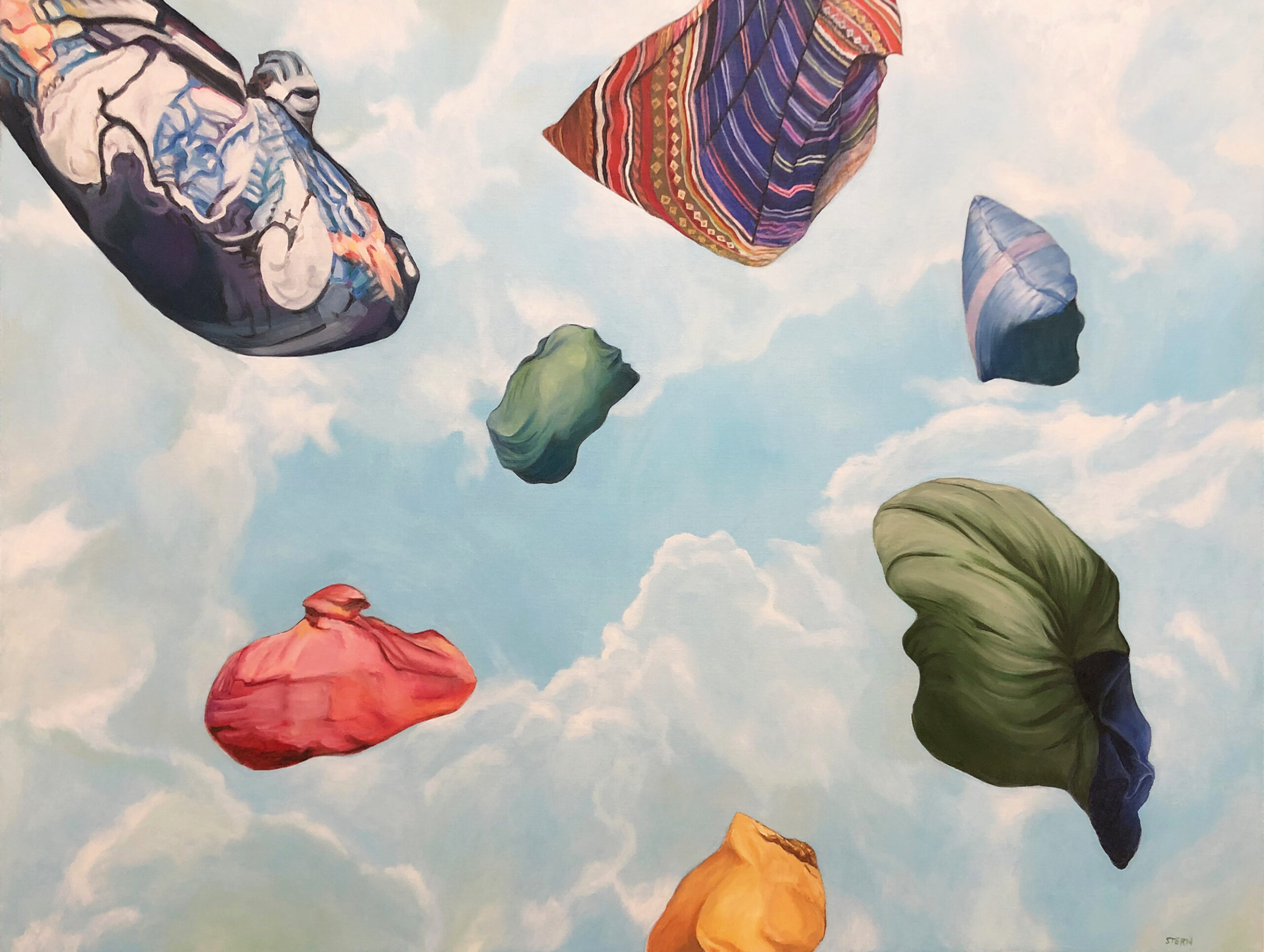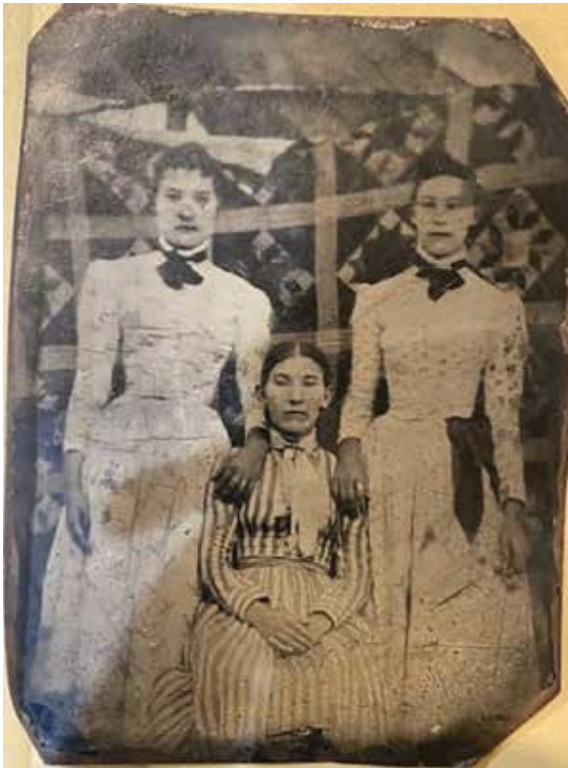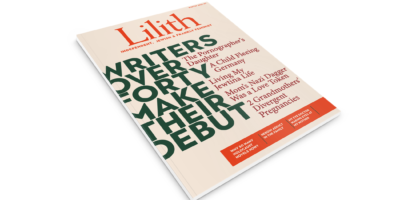
ART: Miriam Stern, “Pekelakh VI”, Oil on Canvas, 36X48
What Language Do You Pray In?
In the lobby of an old hotel along Chicago’s Magnificent Mile, an annual conference for Japanese-English interpreters and translators was underway. I was there too: I had paid for a book table where I could display and sell my English-Japanese technical translators’ dictionary, a labor of love. At the table next to mine was someone from San Francisco who developed translation software. The two of us were the only ones who stayed behind to mind our merchandise while others headed for scheduled workshops.
Then in walked two elderly gentlemen, unescorted and looking lost. They were dressed in suits and ties, as though they were presenters, but no one was there to greet them. Software Guy and I stepped into the vacuum and asked if we could help.
My first impression was right; they were the conference’s two keynote speakers. One, named Ito-san, was a diminutive Japanese American; even I was able to look down on his slicked-back hair and crisply pressed three-piece suit. He carried that aura of professional interpreters, an air of polished invisibility. As an interpreter myself I know how it works—you are supposed to forget us, we are meant to blend into the background. If we didn’t interpret for a living, we could be spies. Maybe we are both. You’ll never know.
His physical stature was deceptive. As we made small talk to pass the time, it turned out that Ito-san had been the United States’ lead Japanese interpreter for most of the latter half of the 20th century serving under both Republican and Democratic presidents. He had top security clearances and has been privy to tense trans- Pacific trade talks and complex re-armament negotiations.
The Question
After a while I asked Ito-san, “What was your most interesting conversation on Air Force One?”
As a prelude to his answer, he told me that he was an evan- gelical Christian. He prays, and his most interesting conversa- tion was with a President who also prayed.
At this he had my full attention. Although I was raised in a non religious interfaith adoptive family, fourth generation unaffiliated on the Jewish side, though we stopped celebrating Passover when I was five and Grandma Paula Kriegman died, I was (and am) transported by religious and spiritual topics. I waited for him to continue.
“On one flight, President Reagan turned to me and asked, ‘What language do you pray in?’ I must have looked perplexed so the President said, ‘What language do you pray in? That’s your true language, isn’t it? The language between you and God.’”
Then Ito-san told me his answer.
“It took me a few moments to sort out an answer. This is what I said to the President of the United States: ‘In congregations, I pray in the language of the congregation, Japanese or English. When I’m alone, I don’t know what words I use. It’s a prayer of the heart.’”
The question intrigued me and his answer has stayed with me over the years as I sort my Jewish and American Indian heritages, learning more and meeting family.
Master Interpreters
The other elderly interpreter waiting with us in the lobby that day was broader-faced, swarthier, with a vaguely Continental air. His name was Peter Less. He said he spoke several European languages but left Europe—and quit interpreting—decades ago.
Masters of their profession, both men brought a breadth of vocabularies, a depth of cultural knowledge, and lightning imaginations to the task of bridging two languages in real-time. This skill is called “simul” for simultaneous interpreting. Most interpreters interpret sequentially, wait for a speaker to finish in the original language before stepping in to re-speak those words in the target language. Simultaneous interpreters do this as soon as the words leave the speaker’s mouth.
To pass the time in the conference lobby, Mr. Less and Ito-san decided to play a parlor game with Software Guy and me by doing multi-lingual simul.
Ito-san, Software Guy, and I understood Japanese. Ito-san and Mr. Less shared la langue Française. They invited Software Guy and me, by turns, to say something in Japanese, then Ito-san interpreted it simultaneously into French as Mr. Less interpreted the French immediately into English. The multi-step transformation took a second or less. We were in language-geek heaven.
I turned to Mr. Less and asked him what he’d been doing since leaving interpreting. His answer shocked me and later helped me clarify for myself what language I pray in.
In navigating my way between North American indigeneity and Jewish exile, I do a kind of personal spiritual simul.
Code-switching
In navigating my way between North American indigeneity and Jewish exile, I do a kind of personal spiritual simul. I suspect my readers do too, because as Jews we’ve been code-switching for two millennia, steering between the channels of the majority culture while preserving the gifts of Jewish life. For me, three ideas about prayer resonate for this.
The first is that religion is the container for our spirituality. It provides a community with which and within which to practice our spirituality. We have used its vessel of liturgy to resist centuries of attempted erasure of our ceremonies/rituals, backstories/ legends, and offerings/communal service.
The second idea is that religion also passes down something already created so we don’t have to invent everything alone, including prayer, although we may not accept all that is offered to us. I reject some prayers or verses and when the congregation’s voices reach them, I read elsewhere in the siddur until I can rejoin the wave of words and we move on together.
The third idea is that spiritual practices inhabit multiple religions; they can transcend their religious containers and we can code-switch between them. When I learned about the blanket- wrapping ceremony held at a pow-wow to welcome back adult indigenous adoptees, I enfolded the image with that of the tallit, the prayer shawl, over which I recite the blessing for ba-tzittzit. The feeling of comfort and inclusion is the same.
Demographics for Prayer?
I’ve struggled with imposter syndrome as much with my Jewish lineage as my Native one. Our communities, in understandable attempts to fight appropriation, sometimes create unnecessary cultural estrangements; both have official rules on who is a member and who isn’t that even a DNA test can’t allay.
Scholarly journal articles have been written about exclusion of those with only patrilineal descent by my Jew crew on the one hand, and “blood quantum” or other requirements for tribal enrollment on the other. In some Jewish movements, having a Jewish biological father is not enough to be considered a Jew so as a child I was told that I wasn’t “really Jewish” because my apparent/adoptive mother was not. As it turns out, my maternal birth relatives are Jewish hence under Jewish law I always was “Jewish”.
Similarly, each sovereign tribal nation has unique rules on who is and isn’t part of the tribe. “Blood quantum” is a common measure but one that does not correlate with cultural engagement or actual genetic markers necessarily. It has led to what Native activists call “paper genocide” or “self-inflicted statistical genocide”. In 2022 several tribes voted to lower or revisit “blood quantum” requirements.
I don’t freight my prayer with these issues of belonging.
Instead, I remember Peter Less’ polite indifference to the conversation about prayer. I remember the contrast to the intensity of his answer when I asked why he left simul.
“I was the head interpreter, you see, at the Nuremberg trials. As soon as they were over, I got my fiancé, who’d spent the war in Switzerland, and we left Europe—forever. My parents, my sister, my grandmother—all died in Germany. I am a Jew, you know.”
“No, I didn’t know,” I say, “I can’t picture how you, you sitting there among those monsters—Nazis making excuses—” I was stumbling for the words, “having to give their excuses a voice. Yet you were a Jew.”
He nodded, “We emigrated to Chicago where I learned and practiced law.” He added with reverence, “I love the law and I love the rule of law.”
I feel a solidarity with those struggling to come back from dispossession; I have tried to pursue tzedek by raising awareness among child welfare audiences about the history and implications of the landmark law, the Indian Child Welfare Act of 1978 (the ICWA), that helped me find my father. I have given tzedakah to several organizations that mounted its defense in the U.S. Supreme Court. The public is familiar with notorious Indian boarding schools in North America but not the statistic that held through the 1970s prior to passage of the ICWA, that a quarter to a third of all children on reservations were removed for adoption and most placed in non-indigenous families.
One of the many good impacts of the Indian Child Welfare Act was a policy change at my old adoption agency. The ICWA made them reveal to me as an adult something they had kept from my adoptive parents: that I had “Indian” paternal ancestry. I love the law and I love the rule of law. In fact, the attorney who drafted the ICWA, Bert Hirsch, lent a hand personally in my search for my father who I would eventually meet. My father told me my ancestors were Cherokee and Mohawk.
Words as Resistance in Prayer
Recently I have been tooling through social media channels dedicated to teaching the Cherokee language (Tsalagi Gawonihisdi). Cherokee, like Hebrew, has survived where other languages under similar pressures became extinct. Mohawk, which is Iroquoian like Cherokee, is not extinct but is categorized as “moribund”. Wikipedia lists about a hundred extinct languages in North America, in some cases even listing the year of their demise
Resistance through language education is what Native activists call “linguistic decolonization” where instructors are “language warriors”. Way sexier than “Hebrew school teacher”, don’t you agree? It took me a long time, starting in college, to learn and reclaim the Hebrew prayer that I wasn’t raised with. I have deep contentment that Hebrew is a vibrant part of my prayer life.
Prayers Without Words
Long before learning about my paternal indigenous roots, I lived in Tokyo for graduate school where I picked up the habit of using incense instead of cinnamon and cloves as the besamim, or sweet spice, for the Havdalah ceremony at Sabbath’s close
Lighting incense was simply the mainstream way to pray in Japan. It’s also in the Torah that I was just beginning to study. Moses is said, in Exodus 30:34, to gather scented oils for aromatic sacrifices and the Talmud specifies eleven ingredients.
One friend who is also part-indigenous and adopted into a family with no indigenous heritage, told me she prays in a manner she learned after reuniting with her Passamaquoddy birth-father: burning sage smudge before hiking her ancestral Wabanaki hills in Maine.
The incense smoke carries her and my prayers upwards with or without words: Native American and Jewish ancestors understood this. But this is not the full answer to the question, what language do I pray in?
Praying on the Land
I’m not unique in using mindful walking as a kind of meditation, praying with my feet and senses, while walking in Creation. Since learning my backstory though, when I pray with my feet and senses, I have the awareness that my ancestors were indigenous; North America is not entirely a diaspora after all and I have taproots in this country.
Those walks have taken on more nuance in recent years as I learned, through absorbed reading, that there was no frontier. What I thought were primeval forests until the arrival of Europeans were often tended game preserves maintained by indigenous people. These lands were already settled by indigenous farmers and hunters and trappers; European “settlers” and “frontiersmen” were invasive squatters, sometimes violently so.

If I Forget Thee
There are broad labels for events like the Babylonian Exile, the Destruction of the Second Temple, and the Holocaust that may have imprinted intergenerational trauma on one side of my family. On the other side there are also the Trail of Tears, Wounded Knee, and federal policies of child removal which represent the grim shared experience of Native American and Jewish histories: physical and cultural genocide.
Most of us have heard of the Ghost Dance. It was based on the prophecies of a mystic whose words spread from tribe to tribe promising that by living right and dancing what is called in English the Ghost Dance, the slain would rise, and the buffalo, that had been their livelihood before being hunted to extinction by “settlers”, would return. Variations promised that the whites would leave or indigenous lands would be returned. The Ghost Dance was a peaceful spiritual movement of resistance.
Infamously, the U.S. 7th Cavalry, which may have been nursing resentments for their defeat under Custer by an alliance of three tribal nations, opened fire on an encampment of children, women, and mostly elderly men near a bend in the Wounded Knee River, where Ghost Dancers congregated. Hundreds were buried at Wounded Knee in a mass grave.
Robbie Robertson, Jewish and Iroquoian member of The Band, distilled their dreams in “The Ghost Dance” which begins:
Crow has brought the message
To the children of the sun
For the return of the buffalo
And for a better day to come
You can kill my body
You can damn my soul
For not believing in your god
And some world down below
You don’t stand a chance against my prayers
You don’t stand a chance against my love
They outlawed the Ghost Dance
But we shall live again, we shall live again
The hopes of Ghost Dancers were spiritual kin to the messianic dreams from the Babylonian Exile in Ezekiel 37:9. Dry bones in a desert valley would rise and be revivified after God commands, “Prophesy to the breath, prophesy, O mortal! Say to the breath: Thus said aDonaI: Come, O breath, from the four winds, and breathe into these slain, that they may live again.”
To this day, Psalm 137 haunts even the bridegroom’s prayers of praise and thanksgiving before he breaks the glass under the chuppah, the words of the Rosh HaShanah Amidah, and weekday prayers:
By the rivers of Babylon,
there we sat,
sat and wept,
as we thought of Zion.
There on the poplars
we hung up our lyres,…
If I forget Thee, O Jerusalem,
let my right hand wither;…
if I cease to think of Thee,
…even at my happiest hour
What language do I pray in? In hereditary connection to Washoe (Cherokee for both “the Cherokee people” and the place where the Cherokee lived). In Am Yisrael with Yisrael, like Washoe, signifying both the people and the place where we are indigenous.
God, Great Spirit, HaShem
Not all is the prayer of exile. When I think of God as a compan- ionable Friend, I pray with a chuckle, thinking of the Reinhold Niebuhr quote, “Humor is a prelude to faith; and laughter is the beginning of prayer” and how every religion has its archetypal trickster (“Man plans, God laughs”). The trickster twin Jacob inhabits Jewish life just as Flint, or Tawiscara, a trickster twin inhabits the creation story of Northeastern tribes while Rabbit, or Jistu, fills the Cherokee role. When I pray in a congregation, I pray to the spirit of a beautiful, ancient and living civilization.
But is the “Great Spirit” of Cherokee religion the same as any or all of the names of God in the Torah? Here I snatch the topic back from the wide angle of community and see it from the tight angle of the deeply personal.
Then, by what language, I am no longer asking what literal language like my halting Hebrew or Tsalagi Gawonihisdi. Now my answer is that I pray in a cultural language. It is fluent in historic indigeneity to Jerusalem and Israel for my Jewish lineage, and to the Old South of Arkansas, Tennessee and North Carolina where I have cousins from my Cherokee lineage (and possibly some Choctaw).
When I pray with my feet and senses, the “Creator” feels equally Jewish and Native American. I see the Divine as vast, and I pray to the holy, the sacred, as sensed and shared through generations, without name or language. When I petition, I try to keep it to acceptance, courage, or wisdom and nothing more.
Still, sometimes I pray with a wink to a companionable trickster because we are celebrants of successful resistance to erasure. Mostly I pray in a portable spirituality tied to nature and people right here in exile with me. This is the cultural language I pray in.
Michele Kriegman’s newest novel, Finding Faith: A Memoirish Novel, touches on the search for her father. After a 15-year career in cybersecurity, she speaks on child welfare and technology topics.


